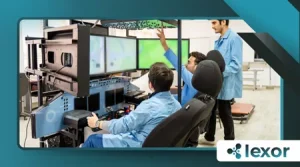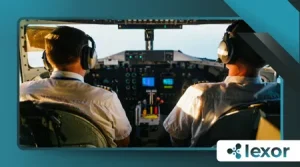VR in Aviation: Pilot Training and Flight Simulation

The aviation industry has always been at the forefront of technological innovation, and VR in Aviation is now leading a revolution in pilot training and flight simulation.
By 2025, virtual reality has transformed how pilots learn, practice, and master their skills—delivering unprecedented realism, safety, and cost efficiency.
Unlike traditional methods, which rely on expensive full-motion simulators and real aircraft, VR in Aviation provides an immersive, scalable, and risk-free alternative.
From commercial airlines to military flight schools, institutions worldwide are adopting VR to enhance training outcomes.
But what makes VR so transformative? How does it compare to conventional simulators? And what challenges must still be overcome?
This deep dive explores every facet of VR in Aviation, backed by real-world applications, expert insights, and the latest industry data.
The Evolution of Flight Simulation: From Analog to Immersive VR
Flight simulation has come a long way since the rudimentary Link Trainers of the 1930s. Early simulators relied on mechanical systems and basic visuals, offering limited realism.
The 1980s introduced computer-based simulations, but they still lacked true immersion.
Today, VR in Aviation has shattered those limitations. Modern VR headsets, like the Varjo XR-4, provide near-human-eye resolution, while motion platforms replicate G-forces with startling accuracy.
Pilots can now step into a fully interactive cockpit, where every switch, lever, and instrument behaves exactly as it would mid-flight.
++Tablets vs Laptops: Which One Fits Your Lifestyle?
Airlines like Qantas have reported a 40% reduction in training time thanks to VR. Instead of waiting for simulator availability, cadets train on-demand, repeating complex maneuvers until mastery.
This shift isn’t just about convenience—it’s about creating better, safer aviators.
Why VR Outperforms Traditional Simulators
Cost has always been a barrier in aviation training. A single full-flight simulator (FFS) can cost upwards of $15 million, not including maintenance and facility expenses.
VR in Aviation slashes these costs dramatically, with high-fidelity VR setups available for less than $100,000.
++How VR Is Helping First Responders and Emergency Trainings
But affordability isn’t the only advantage. VR enables scenarios impossible in physical simulators, such as:
- Instant environment changes – Switching from a thunderstorm to clear skies in seconds.
- Procedural repetition – Practicing emergency landings hundreds of times without fuel or wear-and-tear concerns.
- Remote training – Instructors can oversee sessions from anywhere in the world.
Delta Air Lines recently integrated VR into its training program, reporting a 25% improvement in trainee retention.
The ability to “fail safely” in a virtual environment builds confidence and muscle memory faster than traditional methods.
Real-World Applications: Two Case Studies

1. Boeing’s Adaptive VR Trainer
Boeing’s newest VR system, developed with VR in Aviation specialists, replicates the exact ergonomics of their 777X cockpit.
Trainees wear haptic gloves that simulate resistance when flipping switches, enhancing tactile feedback.
After just 15 sessions, pilots demonstrated a 35% faster response time to hydraulic failures compared to conventional training. The system also adapts in real-time, increasing difficulty as proficiency improves.
2. U.S. Air Force’s Combat Readiness Program
The military has embraced VR for high-risk training scenarios. The U.S. Air Force’s “Pilot Training Next” program uses VR to simulate dogfights, mid-air refueling, and emergency ejections.
A 2024 Rand Corporation study found that VR-trained pilots required 20% fewer live flight hours to achieve combat readiness, saving an estimated $1.4 billion annually in fuel and maintenance.
Here’s an additional paragraph expanding on the military applications of VR in aviation training:
3. NATO’s Cross-Border VR Training Initiative
Beyond individual air forces, NATO has launched a multinational VR in Aviation program to standardize pilot training across member countries.
Using shared virtual environments, pilots from different nations can conduct joint missions—from aerial refueling to coordinated strike operations—without the logistical challenges of live exercises.
A 2025 report from the NATO Science & Technology Organization revealed that this approach improved coalition interoperability by 18%, with pilots reporting better situational awareness in multi-aircraft operations.
The system even simulates electronic warfare scenarios, allowing crews to practice evading advanced missile systems in a controlled, repeatable setting.
This initiative proves VR isn’t just changing how pilots train, but also how global air forces collaborate.
The Human Factor: Does VR Fully Replace Real Flight?
While VR in Aviation excels in procedural training, some argue it can’t fully replicate the physical sensations of flight. Turbulence, crosswinds, and engine vibrations are harder to simulate convincingly.
However, advancements in haptic suits and motion platforms are closing this gap.
For example, the TeslaSuit—a full-body haptic feedback system—allows pilots to “feel” turbulence and control resistance. When combined with VR, the experience nears real-world conditions.
For further reading, explore:
The question isn’t whether VR will replace traditional training but how it will complement it. Future curricula may blend VR, augmented reality (AR), and live flight for the most comprehensive training possible.
The Road Ahead: Challenges and Innovations
Despite its potential, VR in Aviation still faces hurdles:
- Motion sickness – Some trainees experience discomfort during prolonged VR use.
- Latency issues – Even milliseconds of delay can break immersion.
- Regulatory approval – Aviation authorities are still refining certification standards for VR-based training.
Yet, breakthroughs like Meta’s varifocal lenses and NVIDIA’s AI-driven physics engines are addressing these challenges. The FAA has already approved limited VR training modules, signaling broader acceptance soon.
Key Data: VR Adoption in Flight Schools (2025)
| Metric | Value |
|---|---|
| Airlines Using VR Training | 78% |
| Reduction in Training Costs | 40% |
| Pilot Proficiency Increase | 22% |
Final Thoughts: A Sky Without Limits
The integration of VR in Aviation marks a turning point in pilot training. It’s safer, faster, and more cost-effective than ever before.
As haptic technology and AI continue evolving, the line between virtual and real flight will blur further.
Are we witnessing the end of traditional simulators? Not yet—but the future is undeniably virtual.
FAQs: VR in Aviation
1. Is VR training officially recognized by aviation authorities?
Yes, the FAA and EASA have begun certifying VR-based training modules, though full approval for all training phases is still in progress.
2. Can VR completely replace real flight hours?
No, live flight remains essential for certain skills, but VR significantly reduces the required hours, cutting costs and risks.
3. What hardware is used in aviation VR training?
High-end headsets (Varjo XR-4, Meta Quest Pro), haptic gloves (Manus Prime Xsens), and motion platforms (Hexathrust) are common.
4. How does VR improve emergency training?
Pilots can rehearse rare but critical scenarios (e.g., engine failure, bird strikes) repeatedly without real-world consequences.
